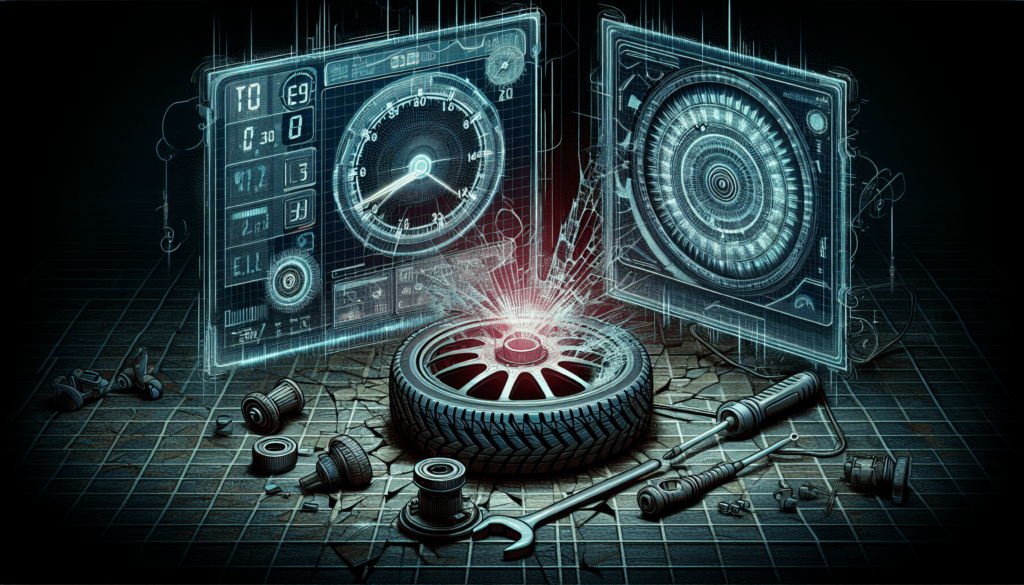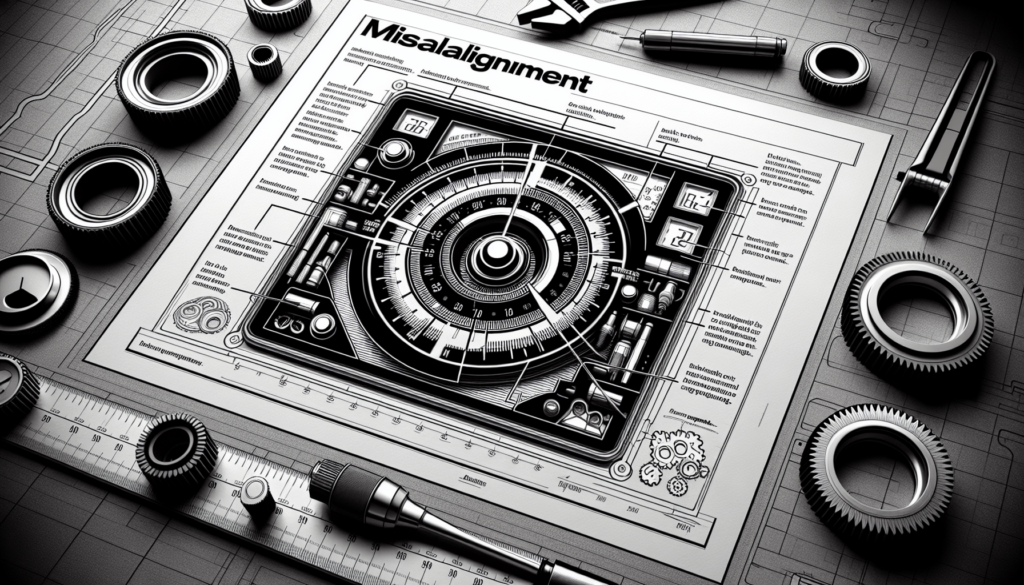In the world of modern technology, digital displays have become an integral part of our everyday lives. From the screen on your mobile phone to the dashboard of your car, these digital displays provide us with important information at a glance. But have you ever wondered if something as seemingly unrelated as misaligned wheels could affect the accuracy of these displays? In this article, we will explore whether there is a connection between misaligned wheels and the accuracy of digital displays, and uncover the potential implications for our daily lives. Hold on tight as we embark on a journey to understand the hidden impact of wheel alignment on our digital world.

Effects of Wheel Misalignment on Digital Displays
Misalignment as a Common Issue
Wheel misalignment is a common issue that affects many vehicles on the road today. While it may not always be immediately noticeable, misaligned wheels can have a significant impact on the accuracy and performance of digital displays in your vehicle. Understanding the potential interactions between misaligned wheels and digital displays is crucial in order to ensure the proper functioning of these important components.
Understanding Digital Displays
Digital displays are an integral part of modern vehicles, providing drivers with crucial information and enhancing their overall driving experience. These displays come in various forms, including dashboard instrument cluster displays, infotainment screens, and head-up displays (HUDs). Each display serves its own purpose, but they all rely on accurate input and readings to provide relevant and reliable information to the driver.
Potential Interactions between Misaligned Wheels and Digital Displays
While it may seem unlikely, misaligned wheels can have direct and indirect effects on the accuracy and performance of digital displays in your vehicle. The mechanism behind this interaction lies in the sensors and systems that rely on precise wheel alignment to provide accurate measurements and information. Misalignment can disrupt the input and calibration of these sensors, leading to inaccurate readings and potentially compromising the functionality of digital displays.
Mechanism of Wheel Misalignment
Causes of Wheel Misalignment
Wheel misalignment can be caused by a variety of factors, including hitting potholes or curbs, improper installation of suspension components, worn-out or damaged steering components, and general wear and tear. These factors can gradually or suddenly lead to misalignment, affecting the alignment angles of the wheels, such as toe, camber, and caster.
Symptoms of Wheel Misalignment
There are several common symptoms that can indicate misalignment, including uneven or rapid tire wear, a vibrating or pulling sensation while driving, steering wheel off-center, and a tendency for the vehicle to drift to one side. If you notice any of these signs, it is important to have your wheels checked for alignment issues as soon as possible to prevent further damage and potential effects on digital displays.
Effects on Vehicle Performance and Safety
Misaligned wheels can have detrimental effects on vehicle performance and safety. When the wheels are not aligned properly, the vehicle’s handling and maneuverability can be significantly impacted. This can result in reduced stability, compromised braking performance, and decreased fuel efficiency. Moreover, misalignment can lead to uneven tire wear, which can shorten the lifespan of your tires and increase the risk of blowouts or flat tires. All of these factors can ultimately have an effect on the accuracy and performance of digital displays.
Types of Digital Displays
Dashboard Instrument Cluster Displays
Dashboard instrument cluster displays provide important information such as speed, fuel level, engine temperature, and warning lights. These displays rely on accurate readings from various sensors in order to provide real-time and accurate data to the driver. Misaligned wheels can affect the accuracy of speedometer readings, leading to inconsistencies in speed display and potential safety concerns.
Infotainment Screens
Infotainment screens are commonly found in modern vehicles and provide a variety of features such as navigation, media playback, climate control, and connectivity options. These screens may rely on GPS data to provide accurate navigation instructions. If the wheels are misaligned, the navigation system may not accurately calculate the vehicle’s position, leading to inaccurate GPS instructions and potentially causing drivers to get lost or miss important turns.
Head-up Displays (HUDs)
Head-up displays, or HUDs, project important information onto the windshield, allowing drivers to view essential data without taking their eyes off the road. Misaligned wheels can cause distortions in HUD projections, leading to inaccurate or difficult-to-read information. This can create a safety hazard, as drivers may struggle to interpret vital information such as speed, navigation instructions, or warning signs.
Digital Display Sensitivity to Misalignment
Impact on Accuracy of Speedometer Readings
One of the most direct effects of wheel misalignment on digital displays is the potentially inaccurate readings displayed by the speedometer. A misaligned wheel can lead to discrepancies between the actual speed of the vehicle and the speed indicated on the digital display. This can not only affect the driver’s ability to accurately gauge their speed but can also lead to potential legal issues if the displayed speed significantly deviates from the actual speed.
Influence on Navigation Systems
Navigation systems heavily rely on accurate input to accurately guide drivers to their intended destinations. When wheels are misaligned, the calibration of the navigation system can be compromised, resulting in inaccurate GPS data and instructions. This can be frustrating for drivers, and it increases the risk of getting lost or missing important turns and exits.
Potential Distortions in HUD Projections
HUDs are designed to provide drivers with essential information in their line of sight, allowing them to keep their eyes on the road. However, misaligned wheels can cause distortions in the HUD projections, making it difficult for drivers to interpret the displayed information accurately. This can be particularly dangerous in situations where split-second decisions are crucial, such as when approaching obstacles or during emergency maneuvers.

Signs Indicating a Potential Problem
Inconsistent Speedometer Readings
If you notice that the speed displayed on your digital speedometer does not match your perception of the vehicle’s speed or deviates from other speed measurement devices, it may indicate a misalignment issue. Inconsistent speedometer readings can be an early sign of misaligned wheels affecting the accuracy of your digital display.
Inaccurate GPS or Navigation Instructions
If your vehicle’s navigation system consistently provides inaccurate instructions or fails to accurately track your position, it may be a result of misaligned wheels affecting the system’s calibration. If you find yourself consistently getting lost or missing turns even when actively following GPS instructions, it is worth considering whether wheel misalignment may be the underlying cause.
HUD Projections Not Aligned with Vehicle’s Perception
If you have a head-up display in your vehicle and notice that the information projected on the windshield does not align with your perception of the road or is distorted in any way, it could be a sign of misaligned wheels affecting the accuracy of the HUD projections. Distortions or misalignment in the HUD can compromise the driver’s ability to quickly and accurately interpret essential information.
Effects of Misaligned Wheels on Vehicle Components
Increased Tire Wear
Misaligned wheels can lead to uneven and rapid tire wear. When the wheels are not properly aligned, specific areas of the tires may bear a greater load than others, causing uneven wear patterns. This not only compromises the overall lifespan of the tires but also increases the risk of blowouts or flat tires, both of which can have serious safety implications.
Uneven Brake System Stress
Wheel misalignment affects the distribution of forces on the brake system. When the wheels are misaligned, some brake components may experience increased stress, while others may not be utilized optimally. This can lead to uneven wear and decreased braking performance, compromising the safety of the vehicle and its occupants.
Damaged Suspension Components
Misaligned wheels can also put additional stress on suspension components such as shocks, struts, and control arms. The misalignment can cause these components to wear out prematurely, leading to decreased stability and compromised handling. In extreme cases, misalignment-related stress can cause significant damage to suspension components, resulting in costly repairs and potentially compromising the overall safety of the vehicle.

Alignment Solutions for Accuracy and Safety
Vehicle Wheel Alignment Procedures
Proper wheel alignment is crucial for maintaining accuracy and safety in your vehicle’s digital displays. Vehicle wheel alignment procedures typically involve adjusting the angles of the wheels, such as toe, camber, and caster, to the manufacturer’s specifications. This process ensures that the wheels are aligned correctly, minimizing the potential negative effects on digital displays and preserving overall performance and safety.
Regular Maintenance and Inspection
Regular maintenance and inspection of your vehicle’s wheels can help identify misalignment issues early on. By visually inspecting the wheels and tires for signs of uneven wear or damage, you can catch potential misalignment before it becomes a more significant problem. Additionally, including wheel alignment checks as part of your routine maintenance schedule can help address any misalignment issues promptly.
Professional Alignment Services
For accurate and precise wheel alignment, it is recommended to seek professional alignment services. Professional alignment technicians have the expertise and specialized equipment necessary to ensure precise alignment of your vehicle’s wheels. By consulting with professionals, you can be confident that your wheels are aligned correctly and that the accuracy and performance of your digital displays are not compromised.
DIY Alignment Techniques
Using Visual Clues
While not as precise as professional alignment, using visual clues can help identify severe misalignment issues. By comparing the orientation of the wheels to straight lines or perpendicular surfaces, such as walls or curbs, you can get a rough idea of whether your wheels are significantly misaligned. However, it’s important to note that visual clues alone may not provide an accurate assessment of alignment and should be used as a preliminary indication rather than a definitive diagnosis.
String and Tape Method
The string and tape method is a DIY alignment technique that involves using strings and tapes to establish parallel lines around the vehicle. By carefully positioning the strings and adjusting them based on the manufacturer’s specifications, you can assess the alignment of your wheels. This method requires precision and attention to detail, as minor errors in string placement can lead to inaccurate alignment measurements.
Online Resources and Tutorials
Numerous online resources and tutorials provide guidance and step-by-step instructions for DIY wheel alignment techniques. These resources often include detailed explanations, diagrams, and video demonstrations to help you understand and perform the alignment process. While these techniques can be useful for basic alignment checks, it is recommended to consult with professionals for more accurate and reliable results.

Professional Wheel Alignment Process
Utilizing Alignment Machines and Tools
Professional alignment technicians utilize sophisticated alignment machines and tools to accurately measure and adjust the alignment angles of each wheel. These machines are equipped with sensors and lasers, allowing for precise measurements and adjustments. The technicians follow the manufacturer’s specifications and recommendations to ensure proper alignment, minimizing any potential effects on digital displays.
Adjustment of Front and Rear Wheels
The alignment process typically involves adjusting both the front and rear wheels to achieve proper alignment. Alignment technicians carefully measure and adjust the toe, camber, and caster angles of each wheel, ensuring that they are aligned according to the manufacturer’s specifications. By addressing misalignment in both the front and rear wheels, technicians can optimize the overall performance and safety of the vehicle.
Final Testing for Accuracy
Once the alignment adjustments have been made, professional technicians conduct final testing to verify the accuracy of the alignment. This may involve driving the vehicle to assess its handling, performing specific tests to ensure proper alignment of the steering and suspension components, and checking the readings on the digital displays. The final testing ensures that the alignment has been successfully performed and that the digital displays are functioning accurately.
Conclusion
The Importance of Proper Wheel Alignment
Proper wheel alignment is essential for maintaining the accuracy and performance of digital displays in your vehicle. Misaligned wheels can have direct and indirect effects on the functionality of these displays, potentially compromising their accuracy and readability. By addressing wheel misalignment, you can ensure that your digital displays provide reliable information to enhance your overall driving experience.
Addressing Misalignment to Preserve Accuracy
It is important to be aware of the signs and symptoms of wheel misalignment in order to address any potential issues promptly. By regularly inspecting your wheels, seeking professional alignment services, or using DIY techniques for preliminary assessments, you can prevent misaligned wheels from affecting the accuracy of your digital displays.
Maximizing Digital Display Performance
Maximizing the performance of digital displays relies on maintaining proper wheel alignment. By addressing and correcting misalignment, you can preserve the accuracy of speedometer readings, ensure reliable GPS and navigation instructions, and prevent distortions in HUD projections. Proper wheel alignment ultimately enhances the overall performance and safety of your vehicle’s digital displays, allowing you to have a more enjoyable and informed driving experience.


